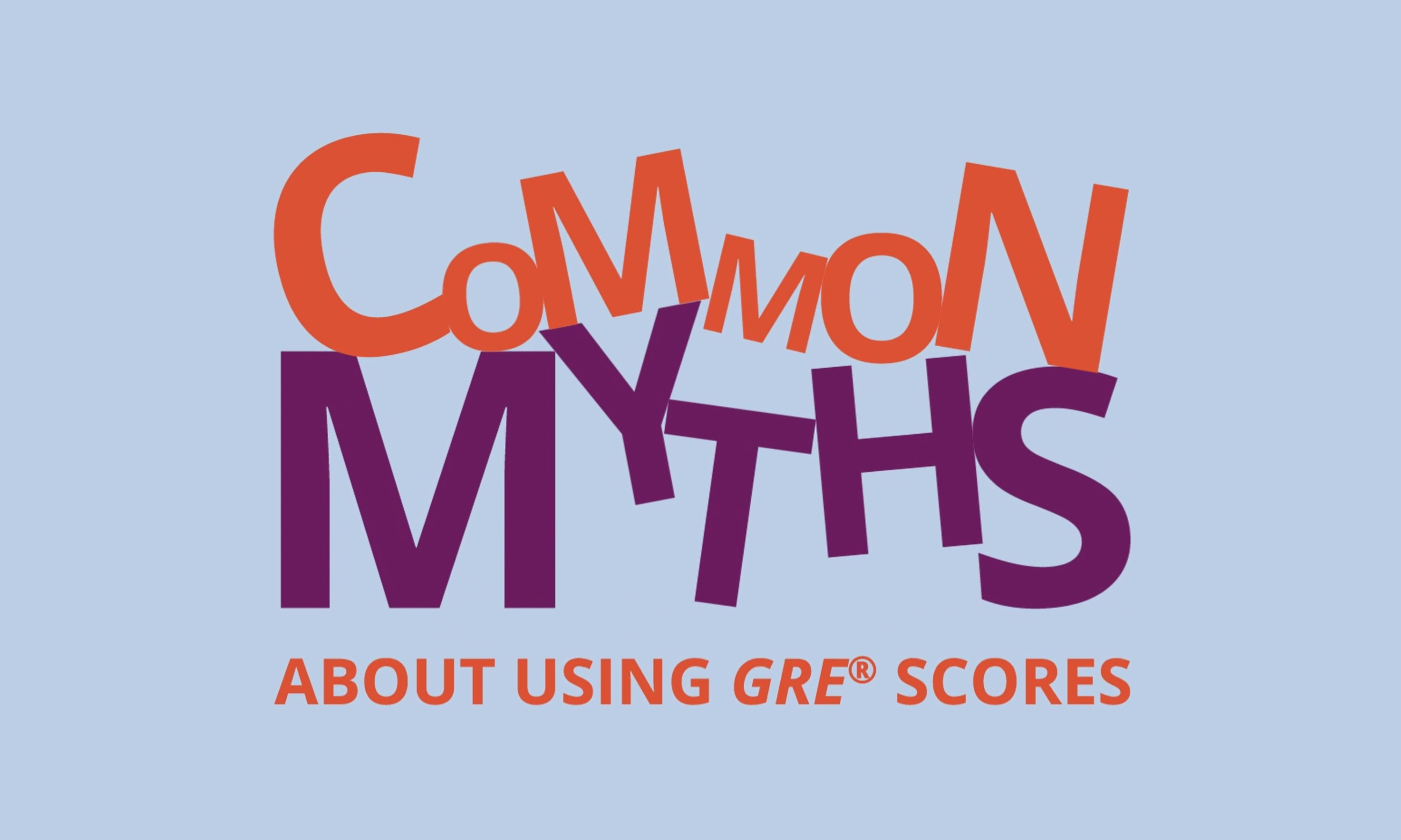Since first introduced, GRE® General Test and GRE® Subject Test scores have provided evidence of skills that are necessary for success in a variety of graduate programs. GRE scores have opened doors for those who had fewer socioeconomic resources and educational opportunities and experiences than their peers. The tests still serve these purposes today.
Please find FAQs and resources below that can help inform the conversations that may be happening on your campus or within your academic networks about the use of GRE scores in admissions. These include a comprehensive slide deck and companion narrative that address questions about validity, test bias and the value of the GRE tests, and an infographic that provides a side-by-side comparison of admissions with and without GRE scores.
-
- As research-based, valid indicators of graduate readiness; GRE General Test scores provide evidence of critical thinking, reasoning and analytical writing skills needed in most graduate, business and law programs, while GRE Subject Test scores provide evidence of undergraduate knowledge that is important for graduate study in particular disciplines.
- As valuable information that needs to be considered alongside other information provided through the application (i.e., letters of recommendation, personal statement, courses taken, undergraduate GPA) to achieve a fuller picture of an applicant.
- To identify specific types of support that may be useful to a student once admitted.
- To evaluate and assess student applications from different countries with different educational systems and different grading scales. It’s the only common denominator available.
See Four Ways to Use GRE® General Test Scores to Evaluate and Support Applicants.
-
- To try to predict anything beyond what they were intended to predict. Other measures of graduate student success, such as degree completion or research productivity, are influenced more by program satisfaction and changes in work and life status — circumstances that tests of academic skills or undergraduate achievement cannot predict. See Why Do So Many Graduate Students Quit?
- As a cut score, even when combined with undergraduate GPA. Using GRE scores by setting a required “minimum” to triage a large applicant pool is a misuse of the scores that may prevent candidates with other desirable qualities from being considered. Also, undergraduate GPA isn’t a reliable measure as it is heavily influenced by the rigor of the undergraduate program, grade inflation and socioeconomic status, with private schools awarding higher GPAs than public schools. See the “Guidelines for Using GRE® Scores” in the GRE® Guide to the Use of Scores.
-
Yes. The validity of the tests has been proven extensively over the span of decades, including newer research that validates the current computer-based GRE General Test. Highlights include:
- A meta-analysis by Nathan R. Kuncel, Sarah A. Hezlett and Deniz S. Ones, which investigated GRE General Test and GRE Subject Test data from over 80,000 graduate students from master’s and doctoral programs, found that the GRE General Test predicts first-year GPA and graduate GPA — as well as faculty ratings of student performance — for both master’s and doctoral program students. The study also concluded that GRE Subject Test scores are better predictors of graduate school success than GRE General Test scores or undergraduate grade point average.
- Regarding research about the predictive validity of each section of the GRE General Test, a study that examined the GRE scores of 25,356 students enrolled in master’s and doctoral programs at 10 institutions found that all three sections of the test are valuable in predicting graduate GPA across many programs of study ranging from the STEM fields to the humanities (Klieger et al., 2014).
- An examination of GRE test scores of MBA students from 12 institutions found that GRE Quantitative Reasoning and GRE Verbal Reasoning scores predict both first-semester MBA GPA and graduate MBA GPA, above and beyond undergraduate GPA (Young et al., 2014).
- A study in collaboration with 21 U.S. law schools, found that the GRE® General Test is a strong, generalizable, and valid predictor of first‐year law school grades that provides useful information even when undergraduate grade point average is available to predict those grades. (Klieger et al., 2018).
See: GRE Validity Resources.
-
When people say this, they are generally referring to a phenomenon that is common among all standardized tests called “group score differences.” This means that, on average, members of different groups perform differently on the test. There can be group score differences among socioeconomic groups, racial/ethnic groups and gender groups.
Extensive research has shown that observed differences in scores can be attributed to a number of factors, including variations in course-taking patterns; interests; and educational, economic and social systems in which everyone does not receive equal opportunity. While preparing for the test can help an individual understand what to expect on test day and brush up on skills they haven’t used recently, it’s a measure of skills acquired over a long period of time. So if someone primarily took coursework that didn’t emphasize the skills measured by the GRE tests, or had significantly fewer educational resources than their peers, it’s understandable how they might not score as well on the test as someone whose courses emphasized the skills measured or who had an abundance of rich educational experiences.
Some people feel that because the tests show group score differences, the tests should be thrown out. ETS — and many who understand the value of standardized tests — compares that to throwing out a thermometer because we don’t want to know it’s hot outside. It’s hot outside whether or not we have the thermometer telling us it is. The thermometer only provides information; discarding it will not help us cool down. Such is the case with group score differences. Rather than throw out the tool that informs us of them — and make important decisions with less information — we should focus on how to account for them to ensure a fair admissions process. The value that GRE scores can bring far outweighs the limitations of group score differences as long as scores are used as part of a holistic approach to admissions, rather than as cut scores, and are used to help identify ways in which institutions can provide support to students whose skills may benefit from additional development in certain areas.
ETS is a nonprofit organization with an educational mission to increase access and equity for all individuals. As one of the world’s preeminent specialists in educational research and assessment, it goes to great lengths to ensure its tests are as free from bias as possible, including following the highest technical standards for test quality and fairness, forming diverse teams to review test questions, training all employees, analyzing test responses using psychometric processes, and eliminating test questions that seem to unfairly bias any particular group. See: ETS Fairness Guidelines. -
Given that group score differences occur, the best way to mitigate them is to adopt a holistic admissions process that considers all relevant applicant information in the decision-making process. It’s a checks-and-balances approach to file review that ensures that all applicants have the opportunity to present multiple aspects of their potential value to the program.
Before considering any applications, ETS advises that programs:- Be aware of what the group score differences are within a particular broad discipline. See A Snapshot of the Individuals Who Took the GRE® General Test.
- Determine how the committee will pay particular attention to applicants who may have had experiences somewhat different from those of the traditional majority.
- Determine the significance of GRE scores in relation to other components of an applicant's file, and then weight those scores accordingly. See the answer to “What exactly is holistic admissions?” below.
- Consider the order in which information is reviewed to avoid the framing bias. See the answer to “What exactly is holistic admissions?” below.
A recent study (Wilson et al., 2019) at The University of Texas MD Anderson Cancer Center UTHealth Graduate School of Biomedical Sciences concluded that an admissions committee can mitigate GRE score variances between demographic groups. The researchers’ recommendations provide a blueprint for institutions that want to implement a data-driven approach to assess applicants in a manner that uses the GRE tests as part of the review process.
Here are other great resources to consult:- Navigating Holistic Admissions “Reviewing Applicant Files” page, which explores alternate review processes.
- Navigating Holistic Admissions “Selecting Applicants” page, which shares suggestions and tools for weighting components of the application packet, including providing a sample rubric.
-
Dropping the tests may reduce some barriers but may also cause others.
When people talk about the test being a barrier, they frequently cite cost and accessibility:Cost: The GRE General Test costs $205 on average. Although this is not significant compared to the cost of applying to or attending graduate school, ETS doesn’t believe that the cost of a test should ever be a barrier to graduate study. And so, we offer three ways for students to pay less — or nothing — to take the GRE® General Test and/or a GRE® Subject Test:
-
Apply for a 50% fee reduction voucher, which is available for individuals who can demonstrate financial need and for those who are unemployed and receiving unemployment compensation.
-
Receive a 50% fee reduction voucher, from one of a dozen programs that serve students from underrepresented groups, first-generation college students, and students with financial need.
-
Receive a full or partial pre-paid voucher, from any sponsoring program, organization or individual.
Accessibility: ETS does everything it can to ensure that everyone who needs to take a GRE test can do so. This includes:
- operating a network of more than 10,000 test centers in 130+ countries
- administering the GRE General Test 24 hours a day seven days a week.
- offering the GRE General Test at home during COVID-19.
- providing industry-leading accommodations for people with disabilities and health-related needs.
- providing excellent, free test preparation materials, including software for the GRE General Test that simulates the real test experience (including accommodations), the entire Analytical Writing topic pool, and additional quantitative exercises.
Although dropping the tests can remove these perceived barriers, it increases the role of others. Dropping the only research-based, common measure from the application review process over-inflates the value of non-standard, subjective information that is easily influenced by socioeconomic status, which can hurt student diversity — the very effect that schools are seeking to avoid.
-
-
The simple act of dropping standardized test requirements or moving to a test-optional policy does not necessarily increase student diversity — it is a complex challenge that one shortcut solution cannot solve. Programs that state that they dropped the GRE requirement and increased diversity often make several changes at once. For example, a program that drops the GRE requirement may also change their recruitment practices, offer more financial support, strengthen their mentoring programs, and work toward making their environments more inclusive. Although these are great things to do, doing them all at once makes it difficult to demonstrate causation since the “experiment” lacked a true “control.”
A recent study (Wilson et al., 2019) at The University of Texas MD Anderson Cancer Center UTHealth Graduate School of Biomedical Sciences concluded that:- It is the practice of using cut scores, not the GRE General Test itself, that disproportionately affects doctoral applicants from underrepresented groups.
- An admissions committee can mitigate GRE score variances between demographic groups.
- A multi-tiered holistic applicant review process can increase the diversity of the applicant pool without increasing the workload of the admissions committee.
Eliminating GRE scores inflates the value of non-standard, subjective information that is not demonstrated to be valid, reliable or fair. Even undergraduate GPAs are influenced by the rigor of the undergraduate program, grade inflation and socioeconomic status, with private schools awarding higher GPAs than public schools.
Without a standard measure, unconscious bias is likely to creep into the process because reviewers will be limited to making admissions decisions based primarily on information highly influenced by the socioeconomic background of the applicant, such as the reputation of the undergraduate institution and the status of recommendation letter writers. Only the GRE measure is backed by research about its validity and reliability. There is little research about the ability of any other components of the application to predict graduate grades or other measures of student success. -
Increasing student diversity is a complex undertaking because educational disparities have deep societal roots, and their effects can be seen by the time children are in kindergarten. Campuses that have been successful enact a multi-pronged approach that focuses on increasing student diversity, faculty diversity and inclusion. There are many successful models for attracting a broader and more diverse student body, such as the University of Maryland, Baltimore County’s Meyerhoff Scholars’ Program, which has been recognized nationally. Other institutions that have adopted all 13 Meyerhoff principles have replicated their success. See: Getting Real About Graduate Diversity and Inclusion.
When it comes to admissions processes and practices that can increase campus diversity, a holistic approach is the best practice, because it balances the benefits and limitations of each component of the application so that each individual is considered fairly. See: Reviewer Diligence and Responsibility in the Graduate Admissions Process. -
At its core, holistic admissions it is a method in which reviewers consider all available information to get the fullest picture of everything that an applicant can bring to a program. Implemented appropriately, it can support a fair and inclusive process that helps to identify applicants that effectively meet program needs and support institutional goals.
While most programs understand that central concepts include using information from multiple sources and avoiding the use of minimum threshold scores, or “cut scores,” there are two other central concepts that can help ensure a fair admissions process:- Give thought to the weighting of various components of the application packet in alignment with program goals and mission. As your program is probably looking for applicants with a combination of various academic and nonacademic skills and attributes, the weighting of various components should reflect the desired outcome. See Using a Holistic Admissions Scorecard for Fair and Consistent Application Review for more information.
- Take care when determining the order in which components are reviewed. How applications are reviewed, by whom, and in what order can result in the framing effect and significantly influence the outcomes. The framing effect is a cognitive bias in which people react to a particular choice in different ways based upon how it was presented. For example, if a reviewer is first exposed to information about an applicant’s low GPA and average GRE scores, the reviewer may review subsequent information with less interest or greater skepticism. If the reviewer is first exposed to evidence of the applicant’s significant contributions to their field or impressive research work, the information about the applicant’s undergraduate GPA and GRE scores may seem less important. See Reviewing Applicant Files for more information on this topic.
-
Absolutely. As a standard measure, GRE scores put applicants from lesser-known undergraduate schools and lower socioeconomic backgrounds on more equal footing with their more advantaged peers. The GRE General Test and GRE Subject Tests are the only parts of a typical application that are backed by solid evidence of their validity and reliability, and that follow specific, rigorous fairness processes. However, they are not flawless. One of the reasons that ETS, the Council of Graduate Schools and other groups promote holistic admissions is that a holistic approach provides “checks and balances” between the areas of relative strength or weakness in a potential graduate student’s application.
A recent study (Wilson et al., 2019) at The University of Texas MD Anderson Cancer Center UTHealth Graduate School of Biomedical Sciences concluded that:- It is the practice of using cut scores, not the GRE General Test itself, that disproportionately affects doctoral applicants from underrepresented groups
- An admissions committee can mitigate GRE score variances between demographic groups
- A multitiered holistic applicant review process can increase the diversity of the applicant pool without increasing the workload of the admissions committee.
Diversity is improved by educating admissions committees on how to make good decisions and having more information is better.
See: Can Holistic Admissions Help Increase Student Diversity?
-
Holistic admissions is a checks-and-balances approach to admissions. The idea is to gather and consider all relevant information about an applicant, including both academic and nonacademic information and both standardized and subjective information. By including all information and considering the weighting and order in which all information is reviewed, decision makers can balance the benefits and limitations of each single component of the admissions packet. Making decisions with less information — and in the case of GRE® General Test scores, three fewer datapoints — isn’t really holistic.


The True Value of the GRE® General Test in Graduate Admissions
The GRE General Test is the only measure of student skills that goes through a rigorous fairness review process and that yields comparative data. This document presents a compelling, evidence-based rationale for its continued use as part of a thoughtful and holistic admissions process.

A Side-by-Side Comparison of Admissions With and Without GRE® Scores
When discussing the benefits of using GRE scores within a holistic admissions process, it’s equally important to acknowledge the negative consequences of making admissions decisions without them. Explore the benefits of including GRE scores compared to the drawbacks of making them optional with this side-by-side infographic.
The Problem in Graduate Admissions is Culture, Not Testing
Concerns about diversity in graduate programs are well-founded — but the answer to increasing diversity isn’t cutting GRE scores from application requirements. Jonathan Malesic, a former full-time faculty member at King’s College, discusses the need to take a look at the culture around admissions to help improve your academy’s diversity.
Contact a graduate education advisor for more information
A number of graduate faculty and administrators serve as graduate education strategic advisors with ETS. Contact them for answers to your questions and consultation on matters of recruitment and admissions.
